Key takeaways:
- Design thinking prioritizes empathy and community engagement, leading to solutions that genuinely reflect residents’ needs and desires.
- Iterative processes, including prototyping and gathering feedback, are essential for refining designs and ensuring they resonate with users.
- Incorporating feedback from community members fosters a culture of collaboration and continuous improvement, enhancing the overall design outcome.
- Active resident participation transforms designs into vibrant communal spaces, enriching community identity and relationships.
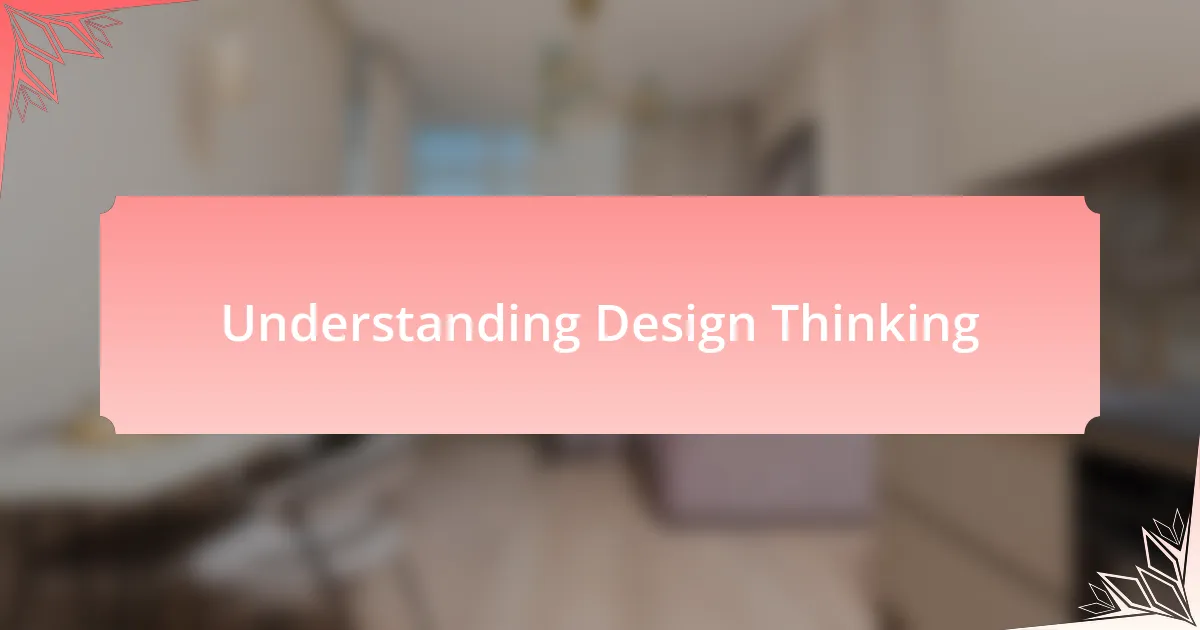
Understanding Design Thinking
Design thinking is all about empathy and understanding the needs of the people you’re designing for. I often find myself reflecting on a moment when I volunteered at a community shelter, where I learned that sometimes it’s the simplest solutions that make the biggest difference. It struck me how important it is to listen and observe before jumping to conclusions—an essential step that can lead to more effective and meaningful outcomes.
At its core, design thinking encourages us to approach problems creatively and iteratively. I remember a community project where we were redesigning a shared urban garden. Instead of imposing our vision, we engaged with local residents, asking them about their experiences and desires. What’s fascinating is that their insights led us to incorporate spaces for gatherings, which became a wonderful hub for connection—something none of us had initially considered.
This process also emphasizes experimentation and acceptance of failure as part of the journey. I recall embarking on a small project to create more seating areas in a neighborhood park. The first design didn’t resonate with the community at all, but through their feedback, we iterated and adapted. Isn’t it interesting how a setback can often lead to a clearer understanding of what truly matters? This openness to feedback is what makes design thinking transformative, fostering innovation and collaboration within communities.
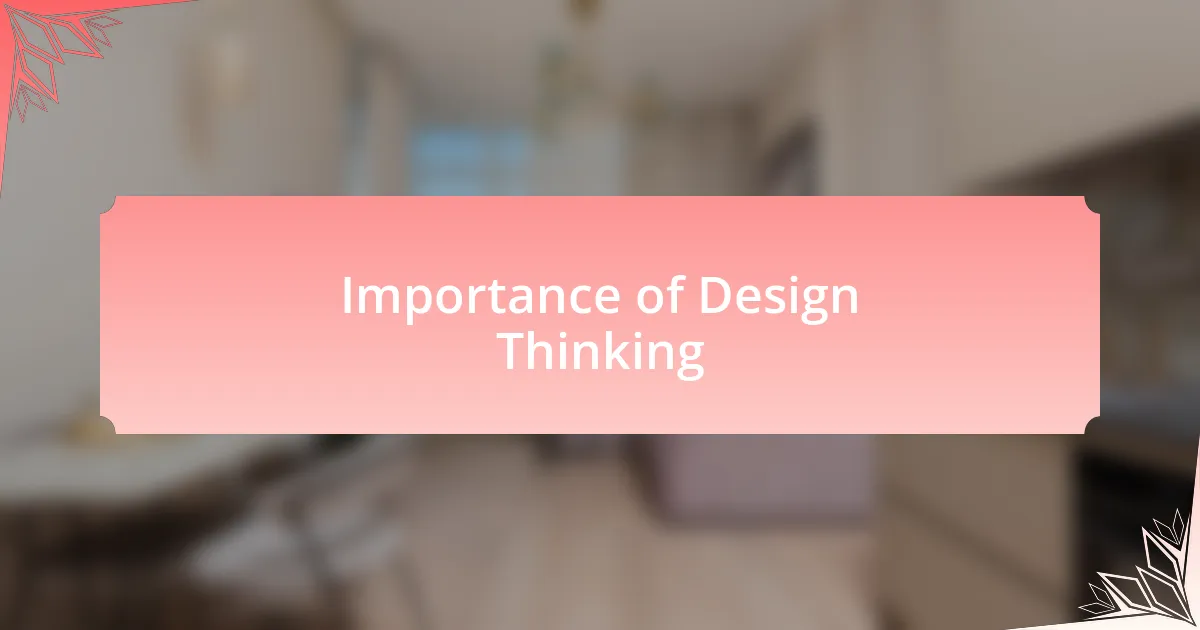
Importance of Design Thinking
Design thinking is fundamentally important because it fosters a deep connection between the designer and the community. I recall a time when we were brainstorming ways to revamp a community center. Engaging with the patrons revealed unexpected desires, such as a space for art classes, which, if overlooked, would have left the project lacking that vital spark. Isn’t it incredible how listening can unlock opportunities we never anticipated?
Moreover, this approach nurtures a culture of continuous improvement. I remember participating in a workshop aimed at redesigning neighborhood playgrounds. After presenting our initial concept, the children—our primary users—shared their thoughts, highlighting the need for inclusive equipment. Their vibrant energy and feedback reshaped our entire approach. How often do we assume we know what people want? Design thinking humbles us, reminding us that the end-users often hold the key to success.
Finally, design thinking encourages collaboration across diverse groups, breaking down silos and uniting people towards a common goal. In one project focused on affordable housing, a cross-section of the community came together, from planners to residents. The synergy created through shared ideas not only improved the designs but also strengthened community ties. It makes me think: how can we leverage this collaborative mindset to tackle bigger challenges we face?
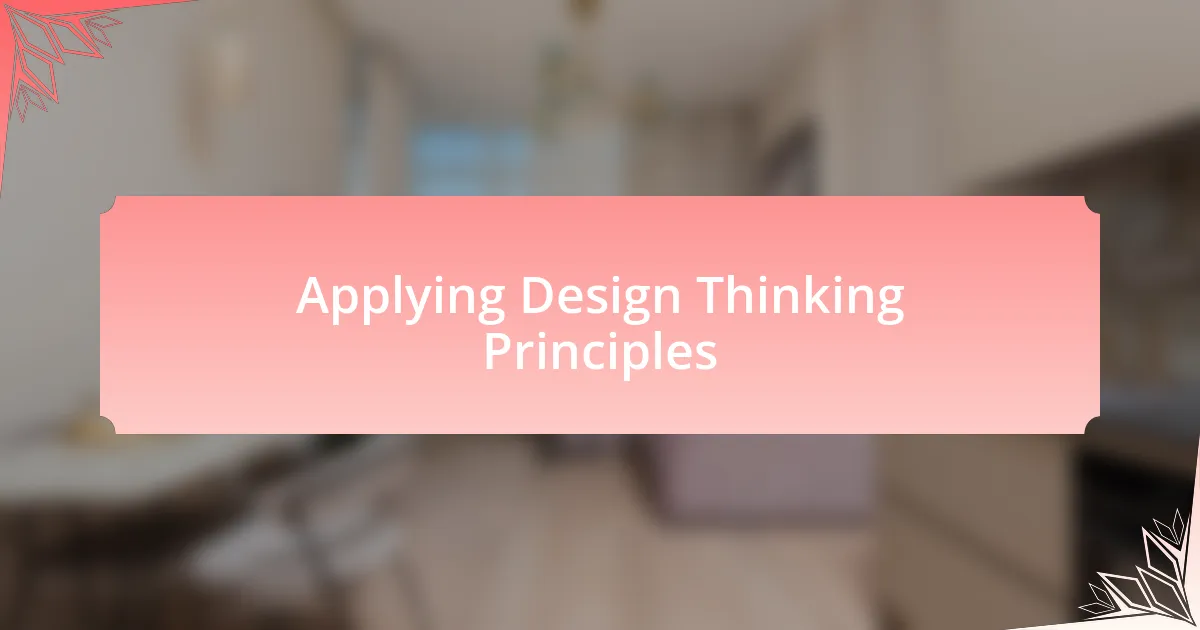
Applying Design Thinking Principles
Applying design thinking principles requires a willingness to empathize with those around us. I recently worked on a project that aimed to redesign a local park. Instead of simply imposing our vision, we held community meetings where residents shared their cherished memories and aspirations for the space. Hearing their stories transformed our perspective—it’s striking how much insight we gain when we truly listen. How can we ensure that their voices remain integral to our design process?
Prototyping is another fundamental aspect of design thinking that I’ve found invaluable. While collaborating on a housing initiative, we developed a scale model of the proposed homes. Inviting feedback on this tangible representation allowed us to discover potential pitfalls early on. I was amazed by how many people had recommendations that we had never considered. Prototyping not only clarifies ideas but also demystifies the process for our stakeholders. Isn’t it fascinating how a simple model can bridge gaps in understanding?
Finally, iteration is essential in the design thinking process. I remember when we launched a pilot program for a community-led urban garden. Initially, the setup didn’t work as intended, but we embraced those setbacks, learning and adjusting with each feedback cycle. This ongoing evaluation kept us grounded in our mission and revealed pathways to further enhance community engagement. Isn’t it liberating to know that every misstep is just another step toward improvement?
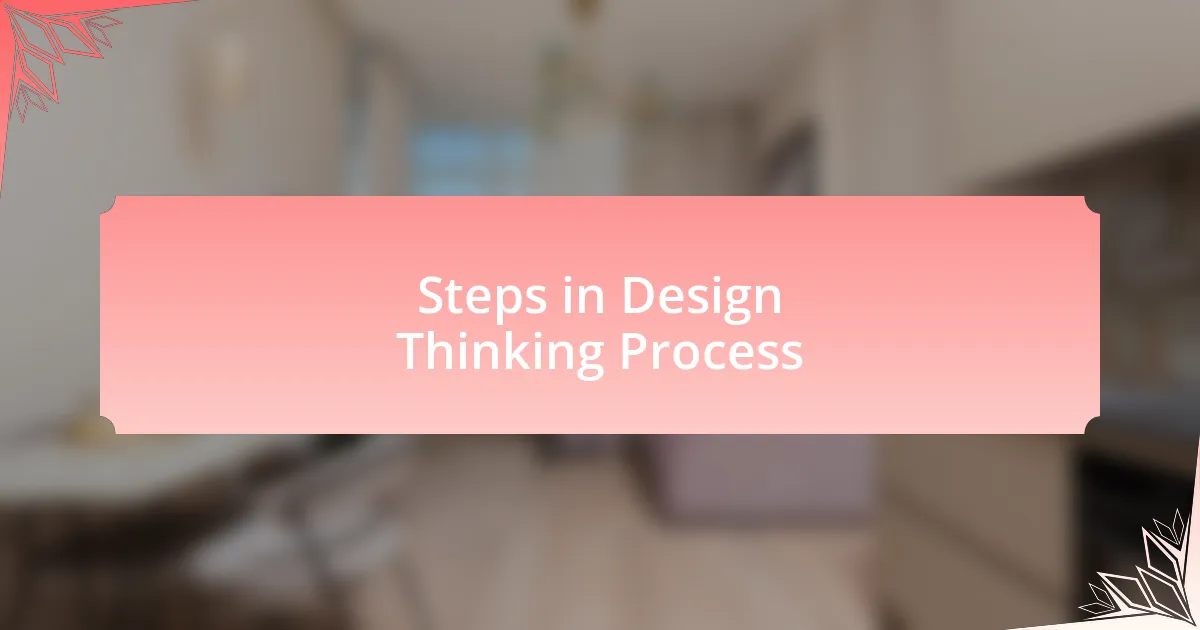
Steps in Design Thinking Process
The design thinking process unfolds in several distinct steps, starting with empathizing. In my experience, this stage is not just about gathering data; it’s about connecting at a human level. I remember attending a workshop where we conducted empathy interviews with prospective residents for a new housing project. Listening to their personal stories of struggle and hope filled me with urgency—how could we design a solution that truly reflected their needs?
Next comes defining the problem—an often overlooked but crucial step. I once participated in a brainstorming session where we mapped out the challenges faced by families seeking affordable housing. It became clear that defining the issue accurately was a collaborative effort. Everyone brought their own perspective, allowing us to pinpoint not only the root causes but also emotional drivers. If we don’t have a clear problem statement, how can we ever hope to find the right solutions?
Once the problem is defined, we move into the ideation phase. I recall a particularly vibrant session where we used sticky notes to capture our ideas, walls becoming a tapestry of thoughts and solutions. This visual brainstorming was electric—it sparked further conversations and led to the most unexpected concepts. It made me realize how powerful collective creativity can be when we embrace a non-judgmental environment. Isn’t it interesting how a room filled with voices can turn into a wellspring of innovation?
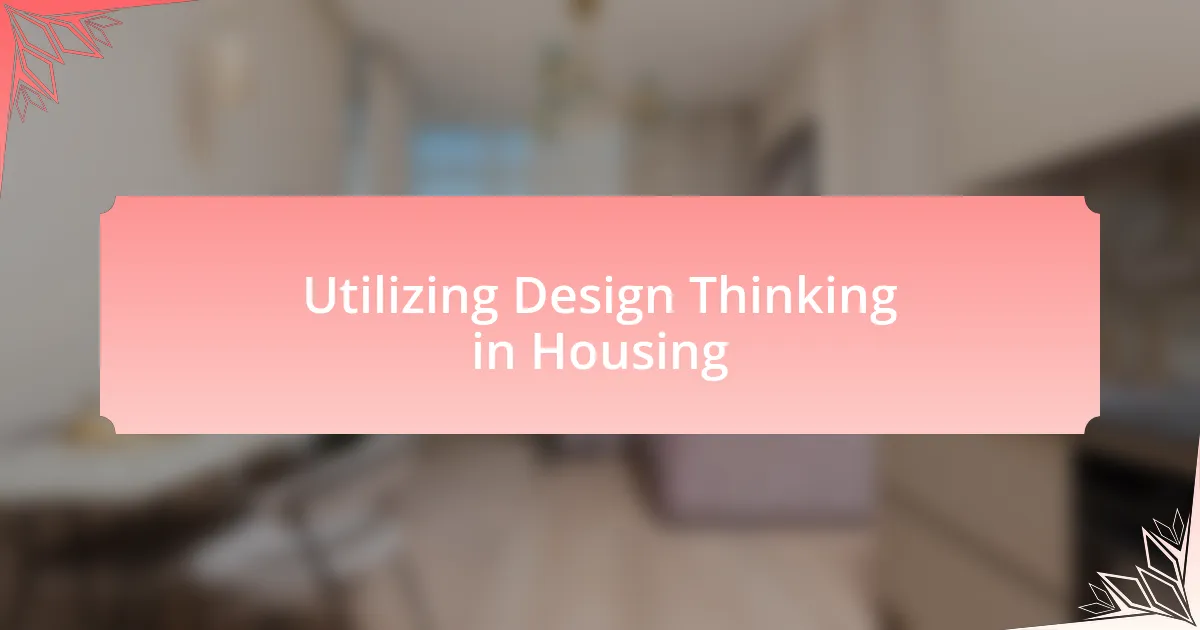
Utilizing Design Thinking in Housing
In the housing sector, utilizing design thinking starts with prototyping, a phase I often find exhilarating. I remember working on a mixed-use development project where we built a scale model of the proposed housing community. It was fascinating to physically see how the spaces interacted and to receive immediate feedback from local residents. Their reactions illuminated aspects we hadn’t considered—what a valuable lesson in ensuring our designs were user-friendly!
Transitioning from prototype to testing, I’ve discovered how crucial it is to involve potential residents in this phase. During a recent community event, we invited people to experience a walkthrough of the space. I watched as families navigated the layout, offering insights and suggestions on how to enhance functionality. Their feedback was invaluable; it reminded me that the best designs emerge when residents are active participants in the process. How often do we overlook the voices of those who will occupy the spaces we create?
Finally, the iteration step in design thinking is where the magic happens. After we incorporated feedback, I felt a sense of fulfillment witnessing the evolution of our design. One resident remarked on how the communal garden area transformed from an idea into a vibrant community hub. It’s moments like these that affirm the importance of adaptability in housing design. Isn’t it remarkable how iterative processes can lead to solutions that truly resonate with the community’s needs?
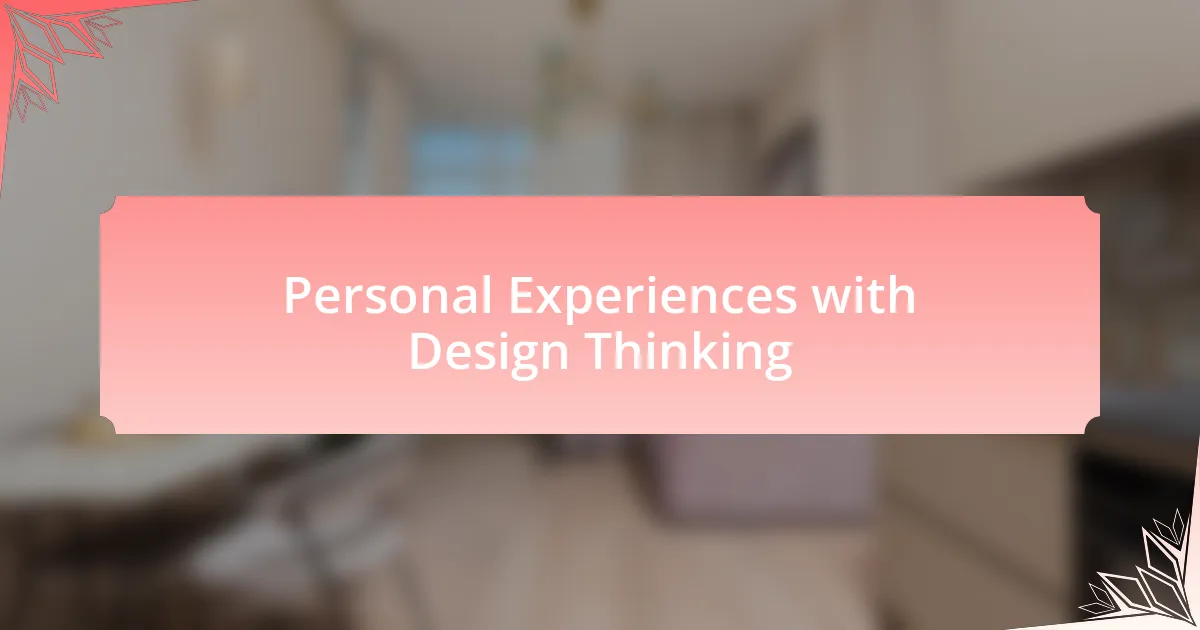
Personal Experiences with Design Thinking
One of my most memorable experiences with design thinking occurred during a community workshop I facilitated. Armed with sticky notes, we invited residents to express their dreams for housing solutions. Seeing their eyes light up as they shared ideas reminded me how powerful collaboration can be. Isn’t it amazing how a simple note can capture a vision that feels larger than life?
I once worked on a project where we faced significant pushback from residents about a proposed community center design. Rather than viewing it as a setback, I saw an opportunity to engage deeper. I set up small focus groups and truly listened to their concerns. It turned out that the design didn’t reflect their culture or daily needs. That moment of empathy shifted everything—it taught me that understanding feelings is just as important as design itself. How often do we challenge our assumptions when we listen actively to the community’s voice?
As I reflect on my journey, I realize how vital it is to embrace uncertainty in the design process. After we rolled out a revised plan, I noticed a remarkable shift in community morale; residents were buzzing with excitement. One mother shared how the new playground layout was not only safer for her children but also a welcoming space for families to connect. These experiences reinforce my belief that design thinking isn’t just a method; it is a mindset that nurtures relationships and fosters community.

Impact on Community Housing Development
Engaging with community members through design thinking has dramatically influenced the way we approach housing development. For instance, I remember a brainstorming session where we used community mapping to visualize spaces that residents cherished. It became clear that preserving green areas was not just a preference; it was a crucial part of their identity. How could we ignore such essential insights when planning new developments?
On another occasion, I collaborated with local artists to incorporate cultural elements into housing designs. This collaboration didn’t just beautify our spaces; it sparked genuine conversations about heritage and belonging. The walls of our community echoed the stories of its residents. Isn’t it fascinating how art can turn a building into a living narrative of a community’s journey?
The moments when I’ve seen community members personally connect with the design have been truly enlightening. At one of our open houses, a resident expressed how a feature designed to foster communal gatherings reignited their neighborhood spirit. It was a reminder that housing is more than shelter; it’s about building relationships and nurturing a sense of belonging. This impact reinforces my belief that actively involving residents in the design process leads to solutions that truly resonate.